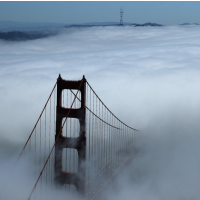After 77 Years, San Francisco Finally Approves Suicide Nets for Golden Gate Bridge
 North tower of the Golden Gate Bridge (photo: Justin Sullivan, Getty Images)
North tower of the Golden Gate Bridge (photo: Justin Sullivan, Getty Images)
California is about 60 deaths away from finally putting in place a suicide barrier to deter jumping off the Golden Gate Bridge.
At least 1,600 people have killed themselves by jumping off the bridge since it opened in 1937, or about 21 a year. Forty-six suicides were reported there in 2013. The rate should drop sharply when a net system to be strung under the iconic landmark is installed by 2018.
The Golden Gate Bridge, Highway and Transportation District voted last week to approve the expenditure of $76 million to install nets about 20 feet below each side of the bridge. The nets should discourage jumpers. Anyone who jumps anyway will likely be injured, but not killed, when they fall into the barrier.
Around 40 people have survived the jump off arguably the most popular suicide location in the world, and almost all of them regretted the action. Jumper Ken Baldwin told The New Yorker, “I instantly realized that everything in my life that I’d thought was unfixable was totally fixable—except for having just jumped.” One survivor leaped a second time and successfully killed herself.
“We did it! It’s no longer the Bridge of Death anymore,” said Sue Story, whose son Jacob jumped off the bridge in 2010. The Bridge Rail Foundation, many of whose members have family and friends who have jumped from the bridge, has been working for years to have barriers installed.
Engineer Joseph Strauss, the man in charge of building the bridge in 1936, arbitrarily lowered the height of the bridge’s railing from a proposed 5-feet, 6-inches high to 4 feet because, in his own words, “The Golden Gate Bridge is practically suicide proof. Suicide from the bridge is neither possible nor probable.”
Jumpers wasted no time proving that he was wrong. Six had died by the time Strauss was felled by a heart attack two years later.
The board voted in 2008 to install a net, but a lack of funding held up the process. Two years ago, a law was enacted providing federal funds for such barriers. Five different designs, mostly involving high fences, were considered. But they were deemed aesthetically unpleasing, disrupting Bay site lines that included Alcatraz. Since then, the net has been designed and environmental review completed.
A study published in the International Journal of Epidemiology showed that such barriers on other bridges cut the suicide rate by 86%. Some jumpers did go elsewhere, but overall the rate fell by 28%.
The motion to approve the net was made by board member John Moylan, according to the Associated Press. Moylan’s grandson Sean Moylan jumped to his death from the Golden Gate Bridge last month.
–Steve Straehley and Ken Broder
To Learn More:
Golden Gate Bridge Board OKs $76 Million for Suicide Barrier (by Michael Cabanatuan, SFGate)
Golden Gate Bridge Suicide Barrier Funding OK’d (by Sudhin Thanawala and Terry Collins, Associated Press)
Nearly One Golden Gate Bridge Suicide a Week as Plans for Safety Barrier Drag On (by Ken Broder, AllGov California)
The Final Leap: Suicide on the Golden Gate Bridge (book by John Bateson)
- Top Stories
- Controversies
- Where is the Money Going?
- California and the Nation
- Appointments and Resignations
- Unusual News
- Latest News
- California Forbids U.S. Immigration Agents from Pretending to be Police
- California Lawmakers Urged to Strip “Self-Dealing” Tax Board of Its Duties
- Big Oil’s Grip on California
- Santa Cruz Police See Homeland Security Betrayal in Use of Gang Roundup as Cover for Immigration Raid
- Oil Companies Face Deadline to Stop Polluting California Groundwater





